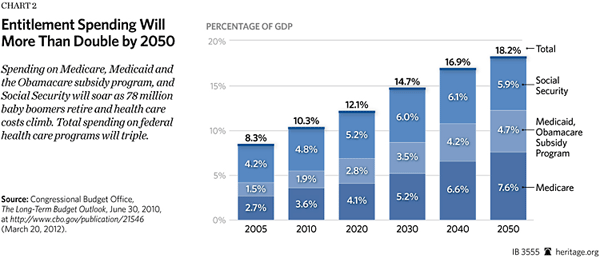The Republican Study Committee (RSC) has once again pushed the outside of the fiscal envelope, presenting a budget that reaches balance in just five years—twice as fast as the group’s proposal a year ago—through entitlement reforms, deep spending reductions, and no tax increases. This aggressive plan incorporates many elements of the House Budget Committee resolution, in some cases going further toward cutting spending.
The RSC budget[1] is a highly ambitious effort that moves as far and fast toward its goals as seems possible. It is not a perfect plan. It falls short in substantiating all its significant spending cuts with adequate substantive policy detail. But it draws another clear, sharp contrast with the President’s vision of ever-expanding government, higher spending, and more debt.
Budget Benchmarks
With its fourth straight trillion-dollar-plus deficit, Washington’s budgetary crisis is growing more entrenched. Spending—especially in the major entitlement programs—continues to run out of control, and the debt is on course to exceed the size of the entire economy within the next two decades. Congress can solve these problems only through bold, decisive actions that curb spending while fulfilling the government’s core responsibilities. In this climate, six key criteria[2] for evaluating a budget are:
1. Does it begin decisive entitlement reform?
2. Does it ensure a strong national defense?
3. Does it cut spending sharply and quickly?
4. Does it avoid tax hikes?
5. Does it contain pro-growth tax reforms?
6. Does it move swiftly to a balanced budget?
The RSC Budget
A budget consists of many elements and should be viewed as a comprehensive whole. Nevertheless, using these benchmarks as a guide, here is how the RSC plan stacks up.
1. Entitlement Reform. The RSC’s proposal clearly recognizes the need to restrain entitlements. It replicates or expands on significant entitlement reforms in the Budget Committee plan (H. Con. Res. 112), authored by Committee Chairman Paul D. Ryan (R–WI).[3] The RSC includes the committee’s transition to Medicare premium support starting in 10 years. It begins a helpful reform to shore up Social Security’s finances by increasing the retirement age starting after 2022. Delaying these reforms, however—“grandfathering the grandparents,” as it is called—forces the RSC to cut more deeply in other areas.
The budget combines Medicaid and the Children’s Health Insurance Program (CHIP) into a single block grant and freezes their total annual funding at $267 billion a year. As with the Ryan budget, putting Medicaid on a budget, rather than its open-ended entitlement status, is a critical first step. The next step should make structural reforms to Medicaid, such as helping mothers and children gain access to private health insurance options while giving the states greater flexibility to develop a more patient-centered safety net for the poor who are elderly and those with disabilities.
In other means-tested welfare programs, such as food stamps and Temporary Assistance for Needy Families, the RSC achieves an aggressive $260 billion in savings over 10 years and then caps overall spending in these programs.
These are worthy ideas, saving a total of $3.357 trillion over 10 years—more than 10 times the Ryan budget’s $331 billion in entitlement savings; and like Ryan, this budget puts teeth in its proposals by employing the fast-track budget reconciliation process to achieve them.
2. National Defense. Also like the committee plan, the RSC budget blocks a catastrophic 10 percent ($55 billion) sequestration of national defense funds in fiscal year (FY) 2013 resulting from the Budget Control Act.[4] It provides the committee level of $554 billion in base defense discretionary spending in 2013 and follows the Ryan budget’s defense spending path thereafter. This approach makes a down payment on future U.S. defense needs and would help rebuild a defense structure drained from 10 years of war.[5] Starting in 2017, the defense budget proposal does not account for Overseas Contingency Operations (OCO) in theaters such as Afghanistan. Conditions on the ground necessary to defending U.S. interests should define future operational requirements. But it is unrealistic to assume there will be no OCO costs in Afghanistan after 2016—an important detail in gauging whether the budget funds defense adequately and whether it can stay within balance.
3. Spending Cuts. To replace cuts from the defense sequestration, the RSC plan slashes other annually appropriated spending. It limits total discretionary spending to $931 billion each year from 2013 through 2017 (excluding funds for activities in Iraq and Afghanistan). This is a deep reduction of nearly 11 percent below the $1.043 trillion Budget Control Act (BCA) cap for 2012, and 9.4 percent below the Budget Committee level for 2013.
4–5. No Tax Hikes; Tax Reform. The proposal contains no tax increases. In the year it reaches balance, 2017, total revenues are the same as under the Ryan budget, $3.642 trillion, or 18.5 percent of gross domestic product. The plan also includes the RSC’s tax reform proposal, titled the Jobs Through Growth Act (H.R. 3400). The RSC’s plan lowers marginal tax rates for families and businesses, reduces taxes on investment, and eliminates deductions and credits in an effort to improve the neutrality of the tax code.
The top marginal tax rate would be 25 percent under the RSC plan. This is considerably below today’s 35 percent top rate and even further below the 44 percent rate that will occur if President Obama’s tax hikes all take effect. Abolishing the dreaded Alternative Minimum Tax (AMT) is another growth-oriented step. The plan would reduce the corporate rate to the international average of 25 percent—well below the current rate of close to 40 percent—making the U.S. more competitive with other developed nations.
The RSC plan would keep tax rates on capital gains and dividends at 15 percent, where they have been for the past 12 years; index capital gains for inflation; and eliminate the death tax. These steps would encourage investment and the job growth that comes with it.
The RSC plan offers a blueprint for pro-growth tax reform that would benefit from more policy detail. While it takes many positive steps, it would have been better had it eliminated all taxes on saving and investment. In addition, instead of abolishing all deductions, exemptions, and credits except for generous family deductions, it would have been better if the plan retained those that are necessary to maintain neutrality.
6. Reaching Balance. If the RSC’s five-year path to balance seems especially ambitious, that partly reflects the depths of today’s budgetary problems. Now in the fourth consecutive year of trillion-dollar deficits—a level previously unheard of—the federal government faces a worsening fiscal challenge as more baby boomers retire, putting excess strain on Medicare and Social Security.
All this makes the RSC’s drive to balance in five years a heavy lift. It requires very aggressive spending cuts that do not have fully fleshed out policy recommendations. This risks calling the plan’s plausibility into question, despite the admirable effort to reach balance even sooner than the RSC proposed last year.
How the Plan Could Be Improved
Even with the strengths cited above, the RSC plan would benefit from more substantive policy detail on how it would achieve its $112 billion reduction in 2013 discretionary spending from the 2012 cap level of $1.043 trillion. This is a tall order that warrants a fuller description; it cannot be accomplished solely through the worthwhile but inadequate eliminations of the Corporation for Public Broadcasting, Legal Services Corporation, National Endowment for the Arts, and National Labor Relations Board.
On the entitlement side, the RSC should explore the effects of its large and rapid cuts in major programs such as Medicaid and CHIP. To be sure, the RSC does not have the same access to the Congressional Budget Office and other resources that budget committees do; but budgets should be driven more by policy than just numerical targets.
Testing the Boundaries
The RSC budget reflects the need to reverse the explosion of federal spending and debt that threatens the country’s economy—and to do so soon. It pushes hard toward the limits of government spending reduction and reform. However ambitious this budget seems, and notwithstanding its limitations, the convictions behind it should not be ignored.
Patrick Louis Knudsen is the Grover M. Hermann Fellow in Federal Budgetary Affairs in the Thomas A. Roe Institute for Economic Policy Studies at The Heritage Foundation. Senior Policy Analyst Curtis S. Dubay contributed to this paper.



